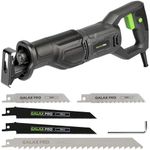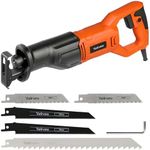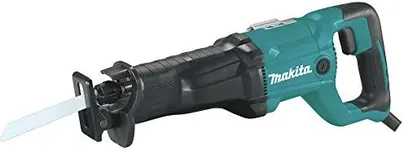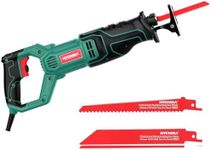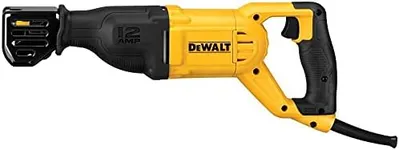Buying Guide for the Best Corded Reciprocating Saw
Choosing the right corded reciprocating saw can make a big difference in your DIY projects or professional work. A reciprocating saw is a versatile tool used for cutting through various materials such as wood, metal, and plastic. To find the best fit for you, it's important to understand the key specifications and how they align with your needs. Here are the main specs to consider when selecting a corded reciprocating saw.Power (Amps)The power of a corded reciprocating saw is measured in amps. This spec indicates the electrical current the motor can handle, which translates to the saw's cutting power. Higher amps mean more power, which is useful for heavy-duty tasks. For light to medium tasks, a saw with 7-10 amps should suffice. For more demanding jobs, consider a saw with 11-15 amps. Choose based on the type of materials you'll be cutting and the frequency of use.
Stroke LengthStroke length refers to how far the blade moves in one stroke. This affects the speed and efficiency of cutting. Longer stroke lengths (around 1-1.25 inches) are better for faster, rough cuts, while shorter stroke lengths (0.75-1 inch) offer more control and precision. If you need to make quick, rough cuts, go for a longer stroke length. For more detailed and controlled cuts, a shorter stroke length is preferable.
Strokes Per Minute (SPM)Strokes per minute (SPM) measures how many times the blade moves back and forth in a minute. Higher SPM means faster cutting. Most reciprocating saws offer variable speed settings, ranging from 0 to 3,000 SPM. For general use, a saw with variable speed control is ideal as it allows you to adjust the speed based on the material you're cutting. Higher speeds are good for softer materials, while lower speeds are better for harder materials.
WeightThe weight of the saw can impact your comfort and ease of use, especially during prolonged tasks. Lighter saws (around 6-8 pounds) are easier to handle and reduce fatigue, making them suitable for overhead or extended use. Heavier saws (9-12 pounds) may offer more stability and power but can be tiring to use for long periods. Consider the duration and type of work you'll be doing to choose the right weight for you.
Blade Change MechanismThe blade change mechanism determines how easy it is to replace the saw blade. Tool-less blade change systems allow you to swap blades quickly and without additional tools, which is convenient and time-saving. Traditional systems may require a wrench or other tools. If you anticipate changing blades frequently or working on varied materials, a tool-less system is highly recommended for its ease of use.
Orbital ActionOrbital action refers to the elliptical motion of the blade, which can make cutting through wood faster and more aggressive. Saws with orbital action settings allow you to switch between straight and orbital cutting modes. For cutting wood, orbital action can speed up the process. For metal or precise cuts, straight action is better. If you need versatility, look for a saw with adjustable orbital action.
Ergonomics and ComfortErgonomics and comfort are crucial for reducing fatigue and improving control. Features like a comfortable grip, anti-vibration technology, and balanced design can make a big difference. If you plan to use the saw for extended periods, prioritize models with ergonomic features. Test the grip and feel of the saw if possible to ensure it fits comfortably in your hand.
